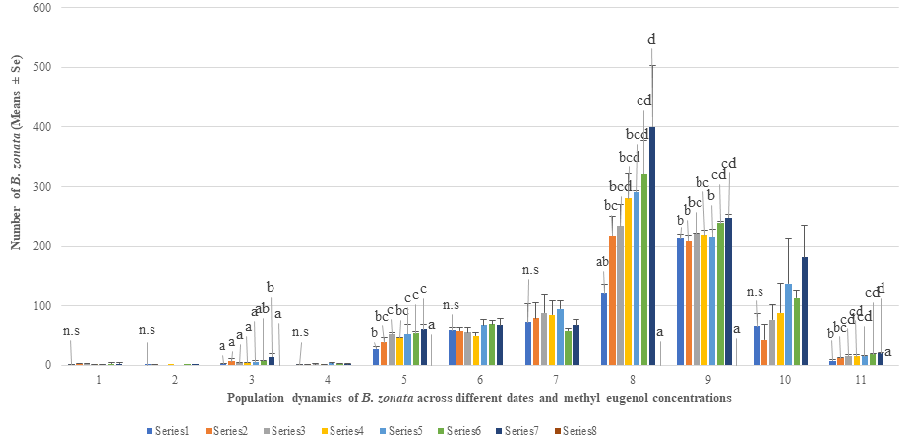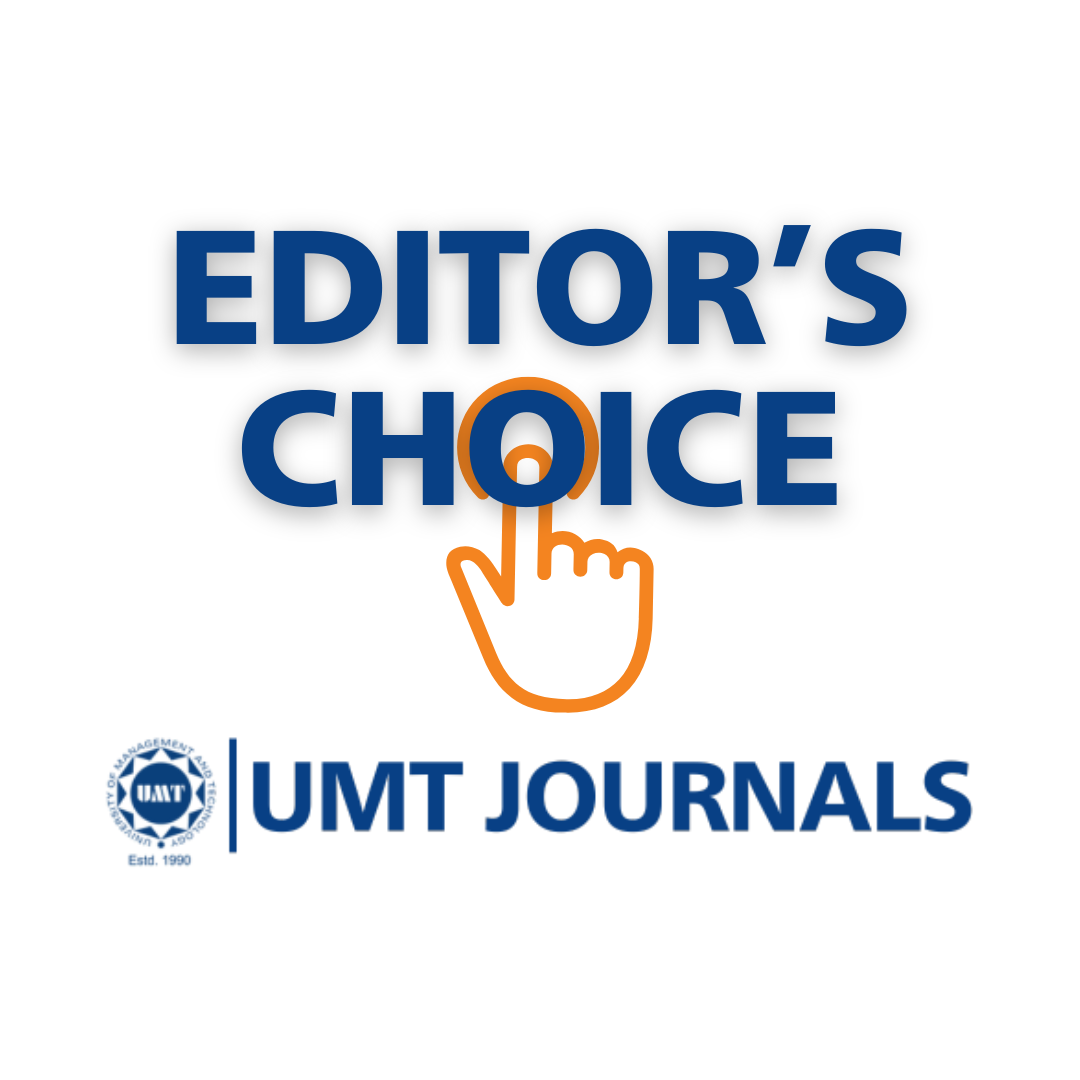Evaluation of Methyl Eugenol Doses against Bactrocera zonata S. (Diptera: Tephritidae) in Ber fruit Orchard in Bahawalpur, Pakistan
Abstract
 Abstract Views: 329
Abstract Views: 329
Among the fruit flies, Bactrocera zonata S. (Diptera: Tephritidae) is native to South and Southeast Asia. It is commonly found in India and Pakistan but it is also found in more than 20 countries in Asian and African regions. In this study, fruit fly male annihilation traps containing different doses of methyl eugenol (ME) attractant, ranging from 0.1, 0.2, 0.3, 0.4, 0.5, 0.75, 1.0 ml dose, and a control treatment (water only) were analyzed. Additionally, a uniform application of one milligram of toxicant Trichlorfon applied in all traps was installed in a Ber orchard in Bahawalpur, Pakistan. The prime purpose of this study was to evaluate the relative efficacy of ME doses against B. zonata in this region. Apart from this, knowledge of seasonal population change could help in controlling these pest insects. Therefore, experiment data for the population was recorded on fortnightly basis from Feb 7, 2018-April 04, 2018 and onward on a weekly basis till May16, 2021 after which the population started to decline. No fruit fly adults were attracted to traps containing water only during all observed dates. Maximum population of B. zonata on Feb 7, 2018, was 3 at ME concentrations of 0.2 ml, 0.75 ml, and 1.0 ml, on Feb 21, 2018, its population was 0.667 at 0.2 ml concentration, on March 07, 2018 the population was 14.667 at 1.0 ml concentration, on March 21, 2018, the population was 3.667 at 0.5 ml concentration, on April 04, 2018, the population was 60.333, on April 11, 2018, the population was 69.000 at 1.0 ml concentration, on April 18, 2018, the population was 94.667 at 0.5ml concentration, on April 26, 2018, the population was 400.670, on May 02,2018, the population was 247.333, on May 9, 2018, the population was 181.667, and on May16, 2018, population was 20.667 at 1.0 ml concentration of methyl eugenol. Thus, more concentrations of ME usually attracted more flies. B. zonata population remained low in February and March. In April the population started to build up and reached its peak at the end of April. In May, the population started to decrease and it declined after mid-May. Correlation with weather factors showed that temperature had a positive while relative humidity showed a negative effect on B. zonata population. This above collected data gave useful information about the population dynamics of fruit flies in the Asian region and an effective attractant dose for the better management of these fruit flies.
Downloads
References
Rashwan AK, Karim N, Shishir MRI, Bao T, Lu Y, Wei C. Jujube fruit: A potential nutritious fruit for the development of functional food products. J Funct Foods. 2020;75:e104205. https://doi.org/10.1016/j.jff.2020.104205.
Lu Y, Bao T, Mo J, Ni J, Chen W. Research advances in bioactive components and health benefits of jujube (Ziziphus jujuba Mill.) fruit. J Zhejiang Univ Sci B. 2021;22(6):431-449. https://doi.org/10.1631/jzus.B2000594
Sarwar M. Occurrence of insect pests on guava (Psidium guajava) tree. Pak J Zool. 2006;38:197-200.
Hussain A, Sajjad A, Salim J. Efficacy of different control methods against oriental fruit fly, Bactrocera zonata (Saunders). J Agric Biol Sci. 2010;5(2):1-3.
Ashfaq M, Khan MA, Gogi MD, Rehman A. Loss assessment and management of Bactrocera zonata (Diptera: Tephritidae) in citrus orchards. Pak J Agri Sci. 2020;57(2):451-456. https://doi.org/10.21162/PAKJAS/19.9310
Enkerlin WR, Reyes- Flores J. Trapping guidelines for area-wide fruit fly programmes. 2nd ed. FAO/IAEA, Rome, Italy; 2018.
Matthews G. Integrated pest management: Principles. In: Brian Thomas, ed. Encyclopedia of applied plant sciences, Elsevier; 2003.
Manoukis NC, Vargas RI, Carvalho L, Fezza T, Wilson S, Collier T, Shelly TE. A field test on the effectiveness of male annihilation technique against Bactrocera dorsalis (Diptera: Tephritidae) at varying application densities. PLoS One. 2019;14(3): e0213337. https://doi.org/10.1371/journal.pone.0213337
Gazit Y, Akiva R. Toxicity of Malathion and Spinosad to Bactrocera zonata and Ceratitis capitata (Diptera: Tephritidae). Fla Entomol. 2017;100(2):385-389.
EPPO. Outbreak of Bactrocera zonata in Israel. EPPO Global Database. https://gd.eppo.int/reporting/article-2786
Noman QM, Shah FM, Mahmood K, Razaq M. Population dynamics of Tephritid fruit flies in citrus and mango orchards of Multan, Southern Punjab, Pakistan. Pak J Zool. 2021;54(1):325-330. https://dx.doi.org/10.17582/journal.pjz/20191021181023
Kumaran N, Balagawi S, Schutze MK, Clarke AR. 2013. Evolution of lure response in tephritid fruit flies: phytochemicals as drivers of sexual selection. Anim Behav. 2013; 85(4):781–789. https://doi.org/10.1016/j.anbehav.2013.01.024
Belavadi VV. Bionomics of the Oriental fruit fly, Dacus dorsalis Hendel (Diptera: Tephritidae) on guava (Psidium guajava L.) and its control by male annihilation [Master’s thesis]. UAS-Bangalore, 1979.
Nishida R, Shelly TE, Kaneshiro KY. Acquisition of female-attracting fragrance from a Hawaiian lei flower, Fagraea berteriana, by males of the Oriental fruit fly. J Chem Ecol. 1997;23:2275-2285. https://doi.org/10.1023/B:JOEC.0000006673.27221.2e
Prabhakar C, Sood SP, Mehta PK. Pictorial keys for predominant Bactrocera and Dacus fruit flies (Diptera: Tephritidae) of north western Himalaya. Arthropods. 2012;1(3):101-111.
Mulyadi R, Wilyus, Novalina. Number of fruit flies (Diptera: Tephritidae) trapped in various combinations of methyl eugenol dosages and trap colors. IOP Conf Ser Earth Environ Sci. 2021;667:e012085.
Rizk MMA, Abdel-Galil FF, Temerak SAH, Dalia Darwish YA. Factors affecting the efficacy of trapping system to the peach fruit fly (PFF) males, Bactrocera zonata (Saunders) (Diptera: Tephritidae). Arch Phytopathol Pflanzenschutz. 2014;47(4):490-498. https://doi.org/10.1080/03235408.2013.813110
Haider SS, Hassan MW, Iqbal M, Jamil M. Comparative efficacy of three different insecticides against adult fruit flies Bactrocera zonata (Saunders) (Diptera: Tephritidae) under laboratory conditions. Arthropod Manag Tests. 2021;46(1):tsab130, https://doi.org/10.1093/amt/tsab130
Ali I, Ullah F, Khan SA. Efficacy of various insecticides and trap heights in methyl eugenol traps against fruit flies (Bactrocera spp.). Sarhad J Agric. 1999;15(6):589-594.

Copyright (c) 2022 Dr. Ghulam Sarwar, Muhammad Waqar Hassan, Allah Bakhs, Sohail Maqsood

This work is licensed under a Creative Commons Attribution 4.0 International License.
BSR follows an open-access publishing policy and full text of all published articles is available free, immediately upon publication of an issue. The journal’s contents are published and distributed under the terms of the Creative Commons Attribution 4.0 International (CC-BY 4.0) license. Thus, the work submitted to the journal implies that it is original, unpublished work of the authors (neither published previously nor accepted/under consideration for publication elsewhere). On acceptance of a manuscript for publication, a corresponding author on the behalf of all co-authors of the manuscript will sign and submit a completed the Copyright and Author Consent Form.









